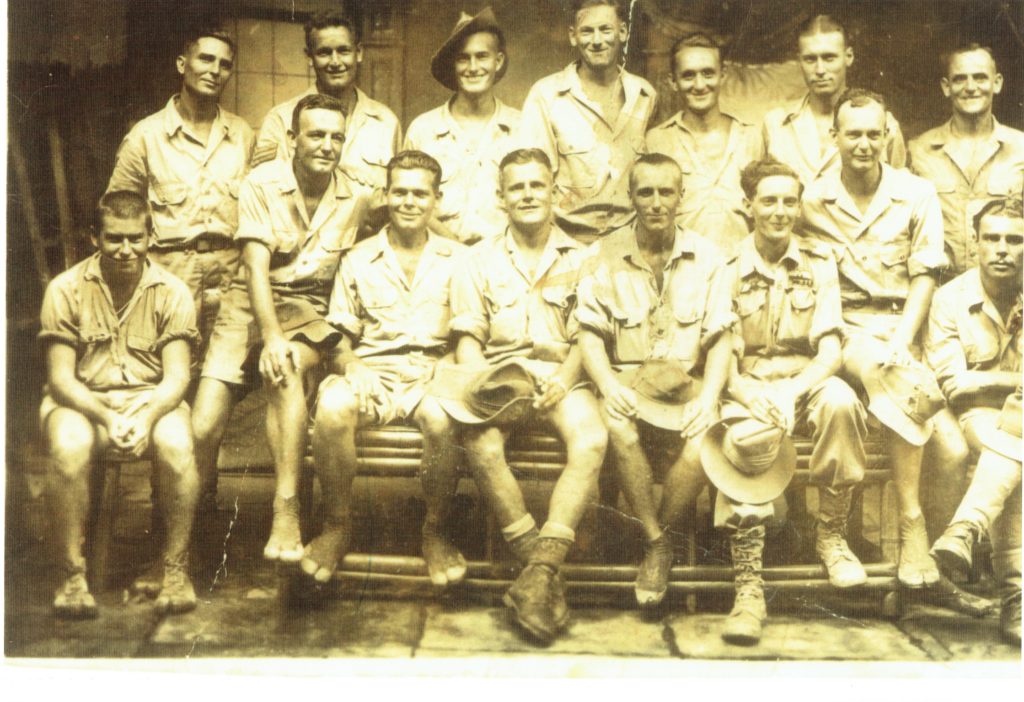Nakom Nayok, Nakhon Nayok - Thailand
Nakom Nayok, Nakhon Nayok – Thailand

Back: L-R Clarrie McDonald, Joe Pearce, George Neville, R. Anderson, D Robertson, Ralph Williams, ?
Front: L-R Clive (Potty) White, Charles Fielder, Jim Basel, Reg Stewart, Roy Matthews, Pommie Para, Sid Webb, N. Simmonds
Nakon Nayok April to July 1945 held about 2,000 British, Australian and a few American POWs.
The Camp as described by Les Cody “Ghosts in Khaki” was built in paddy fields sitting on a water table no more than a few feet below the surface. The latrines were earth mounds built on top of this surface. When it rained the paddy fields flooded and sewerage flowed through the camp.
Their work here was digging. The men dug trenches and tunnels into the large range of hills circling the camp. This was to store supplies and petrol drums, thought to have been aviation fuel for the Imperial Japanese Army Air Service. In other words, defence for the Japanese!
In April a large work force group arrived in April 1945 from Kachu Mountain Camp where they had constructed an aircraft runway. Included were about 50 men from 2/4th who had first come together from ‘A’ and ‘D’ Forces at Chungkai and had decided to try to remain together. Amongst this group was Les Cody, Roy Matthews, Syd Webb, Clive ‘Potty’ White, Ralph Williams and John Morgan.

Above: Jmmy Smith
The highlights of their journey from Kachu Mountain included meeting and exchanging greetings with a group of French nuns at a wayside siding. The first time in 3 years where there was an opportunity to communicate in a civilised manner! The highlight of that overnight stop was the camp fire concert permitted by their rather friendly guards.
It was apparently a glorious moonlit tropical night, the men had finished their food and were seated around a cheery fire and listened to Jimmy Smith who had a lovely tenor voice sang a selection of old favourite songs. The audience remained absolutely silent isolated in their own magical world of song and memories – ignoring the nearby Japanese guards and the presence of Thai natives gathered in the darkness beyond.
Jimmy’s performance and the night was never to be forgotten.
The next morning the train journey resumed and was punctuated by occasional Allied aircraft until the men finally began a 20 hour non-stop march into the camp. The men were exhausted and unable to persuade the guards to rest at all. The men were belted back from sleep as they staggered and fell over the track.
The POWS arrived 7 July 1945 – they had travelled 45 km, the men moving without food or boots for 33 hours continuously. The work was hard and long here – consisted mainly digging.
They dug dugouts, ammo dumps, trenches or tunnels into the side of the a hill to store supplies and what was thought to have been aviation fuel for the Imperial Army Air Service.
The Japanese were nervous as were the POWs – wondering how much longer before they would be killed. The tension was tremendous – so was the weather. Electrical storms and rain. The Camp was constantly under water and their conditions miserable.
The Australians organised themselves into three groups which would all attempt escape in different directions if it became necessary.
On about 16 or 17 August, the atmosphere changed – the local Thais advised the end of the war. Thai supply truck arrived with food.
The British, American and Dutch flags were flying. A plane dropped men and supplies on 1st September – an amazing sight!
